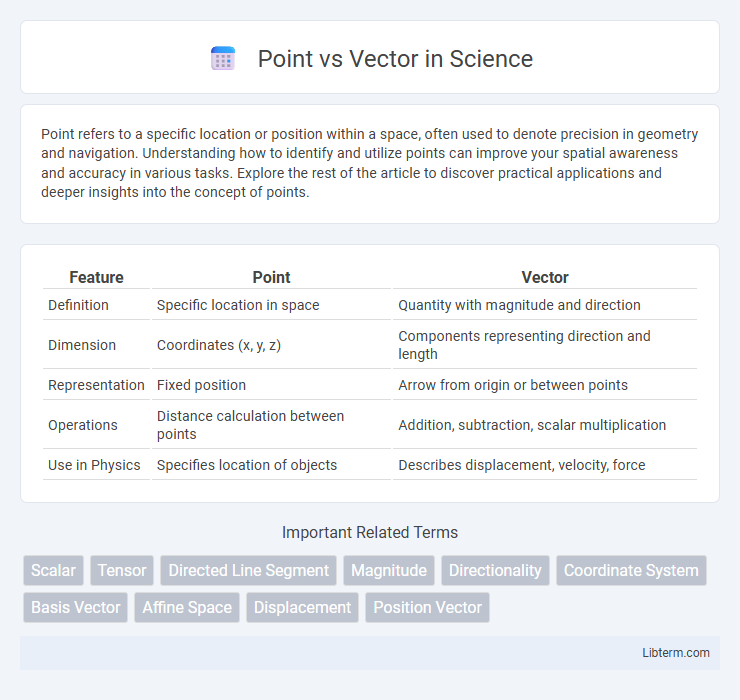Point refers to a specific location or position within a space, often used to denote precision in geometry and navigation. Understanding how to identify and utilize points can improve your spatial awareness and accuracy in various tasks. Explore the rest of the article to discover practical applications and deeper insights into the concept of points.
Table of Comparison
| Feature | Point | Vector |
|---|---|---|
| Definition | Specific location in space | Quantity with magnitude and direction |
| Dimension | Coordinates (x, y, z) | Components representing direction and length |
| Representation | Fixed position | Arrow from origin or between points |
| Operations | Distance calculation between points | Addition, subtraction, scalar multiplication |
| Use in Physics | Specifies location of objects | Describes displacement, velocity, force |
Introduction to Points and Vectors
Points represent specific locations in a coordinate system, defined by fixed coordinates such as (x, y, z) in 3D space. Vectors describe direction and magnitude but do not have a fixed position, often represented as arrows pointing from one location to another. Understanding the difference between points and vectors is fundamental in fields like computer graphics, physics, and mathematics for spatial analysis and transformations.
Fundamental Definitions: Point vs Vector
A point represents a specific location in space defined by coordinates, such as (x, y, z), without magnitude or direction. A vector describes a quantity with both magnitude and direction, often represented as an ordered set of components indicating displacement or force in space. Points are positional markers, whereas vectors characterize movement or change relative to an origin.
Mathematical Representation
A point in mathematics is represented as an ordered tuple of coordinates, such as (x, y, z), indicating a specific location in space. A vector is expressed as an ordered list of components, often written as
Geometric Interpretation
A point in geometry represents a specific location in space defined by coordinates, while a vector indicates both direction and magnitude from an initial point. Vectors can be visualized as arrows originating from the origin or any point, showing displacement, whereas points signify fixed positions without inherent direction. Understanding the distinction is crucial for applications in physics, computer graphics, and spatial analysis, where points locate objects and vectors describe movements or forces.
Properties and Characteristics
A point represents a specific location in space defined by coordinates, without magnitude or direction, while a vector embodies both magnitude and direction, indicating displacement or force. Points are immutable reference positions used for defining geometry, whereas vectors can be added, scaled, and used to convey movement or change between points. Vectors possess properties such as length (magnitude) and direction, often expressed in component form, whereas points lack these attributes and serve as fixed markers in spatial analysis.
Operations Involving Points and Vectors
Operations involving points and vectors differ fundamentally; points represent locations in space while vectors denote directions and magnitudes. Adding a vector to a point results in a new point, translating the original position by the vector's magnitude and direction. Subtracting two points yields a vector that defines the displacement between these positions, essential for calculating distances and directions in geometry and physics.
Real-World Applications
Points represent specific locations in space with fixed coordinates, commonly used in GPS mapping and computer graphics for accurate positioning. Vectors describe direction and magnitude, crucial in physics for modeling forces, velocity, and motion in simulations and engineering design. Combining points and vectors enables precise navigation, robotic movement, and 3D rendering in virtual environments.
Differences Between Points and Vectors
Points represent specific locations in space defined by coordinates, whereas vectors denote direction and magnitude without a fixed position. Unlike points, vectors can be added or scaled algebraically to describe movement or force, while points serve as reference positions. In geometry and physics, points identify positions, and vectors describe displacements or directions between these points.
Visualizing Points and Vectors in Space
Points represent specific locations in space with fixed coordinates, while vectors denote direction and magnitude without a fixed position. Visualizing points involves plotting exact positions on coordinate planes or in 3D space, whereas vectors are illustrated as arrows originating from an initial point, indicating movement or force direction. Understanding this distinction enhances spatial reasoning in mathematics, physics, and computer graphics, facilitating precise modeling and analysis.
Summary and Key Takeaways
Points represent specific locations in space defined by coordinates, while vectors describe direction and magnitude without a fixed position. Understanding the distinction is crucial in geometry, physics, and computer graphics for accurate spatial representation and transformations. Key takeaways include recognizing points as positional references and vectors as tools for measuring displacement and direction between points.
Point Infographic

 libterm.com
libterm.com